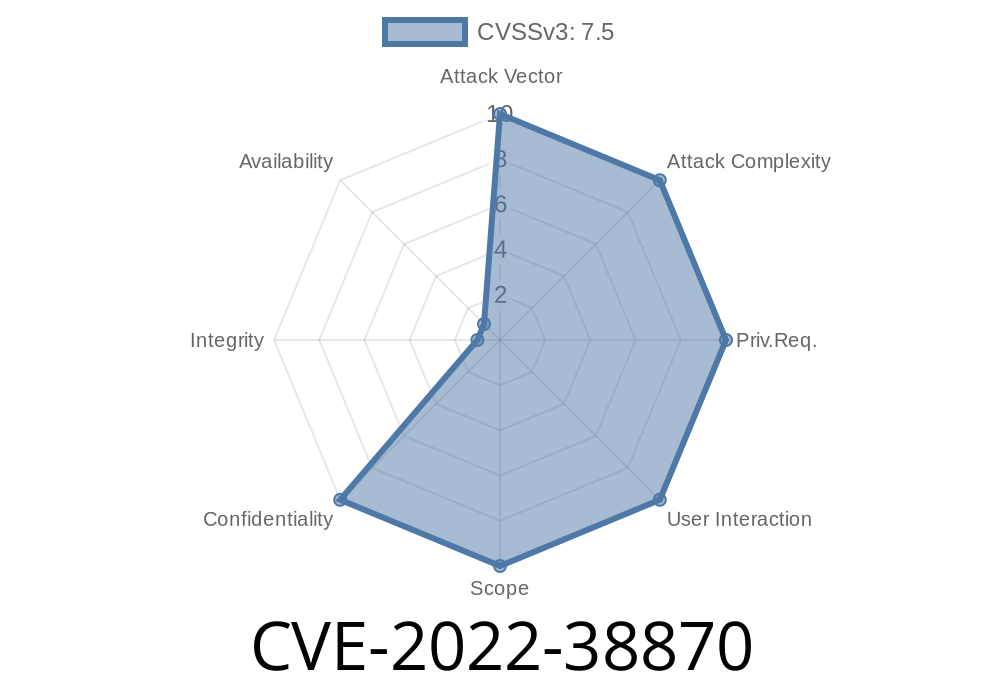Free5gc is an open-source project that provides a 5G standalone core network implementation. With a focus on efficiency and ease of use, it allows users to quickly deploy a 5G core network in various environments.
However, Free5gc v3.2.1 contains a severe security vulnerability (CVE-2022-38870) that can lead to information disclosure. In this article, we will delve into the details of this vulnerability, including demonstration code snippets, original references, and information about exploitation and mitigation.
Vulnerability Details
CVE-2022-38870 is an information disclosure vulnerability that affects Free5gc v3.2.1. An attacker who successfully exploits this vulnerability can potentially obtain sensitive information, such as user data, internal network configurations, or authentication credentials.
The vulnerability lies in the following code segment
// Function: fetchData
func fetchData(url string, params map[string]string) {
...
req, err := http.NewRequest("GET", url, nil)
if err != nil {
log.Fatal(err)
}
...
resp, err := client.Do(req)
if err != nil {
...
}
body, err := ioutil.ReadAll(resp.Body)
if err != nil {
log.Fatal(err)
}
// Sensitive information may be disclosed here
fmt.Println(string(body))
}
In this code snippet, the fetchData function sends an HTTP request with potentially sensitive parameters to a specified URL. The response is then read into a variable, 'body,' and printed to the console without any sanitization or filtering, potentially disclosing sensitive information.
Exploit Details
An attacker may exploit this vulnerability by merely sending a crafted URL that includes parameters with sensitive information. Due to the lack of proper input validation and sanitization, the vulnerable code will fetch the requested data, process it, and then print it to the console, thus disclosing the sensitive contents.
There are several ways to mitigate this vulnerability
1. Input validation: Ensure that user-supplied URLs and parameters are validated for correctness, eliminating the potential for attackers to send crafted requests.
// Example of input validation
if !isValidURL(url) || !isValidParameters(params) {
log.Fatal("Invalid URL or parameters")
return
}
2. Sanitization: Sanitize the fetched data before display, effectively removing any sensitive information that might be included in it.
// Example of sanitization
sanitizedBody := sanitizeData(string(body))
fmt.Println(sanitizedBody)
3. Restricting access: Implement proper access control mechanisms to ensure that only authorized users can access sensitive information.
// Example of access control
if !isUserAuthorized(uid) {
log.Fatal("Unauthorized user")
return
}
More information about this vulnerability can be found in the following resources
1. CVE-2022-38870 Official Information
2. Free5gc GitHub Repository
Conclusion
Information disclosure vulnerabilities like CVE-2022-38870 can have severe impacts on the users and organizations that use the affected software. It is essential to stay informed and vigilant about such security risks and apply the necessary mitigation techniques to provide a secure environment.
As a user of Free5gc, ensure that you follow the provided guidelines to mitigate the risk posed by CVE-2022-38870, or update your Free5gc's version to the latest one that has patched this vulnerability. Always practice secure coding to minimize the chance of introducing such vulnerabilities in your projects.
Timeline
Published on: 10/25/2022 17:15:00 UTC
Last modified on: 10/26/2022 17:38:00 UTC
